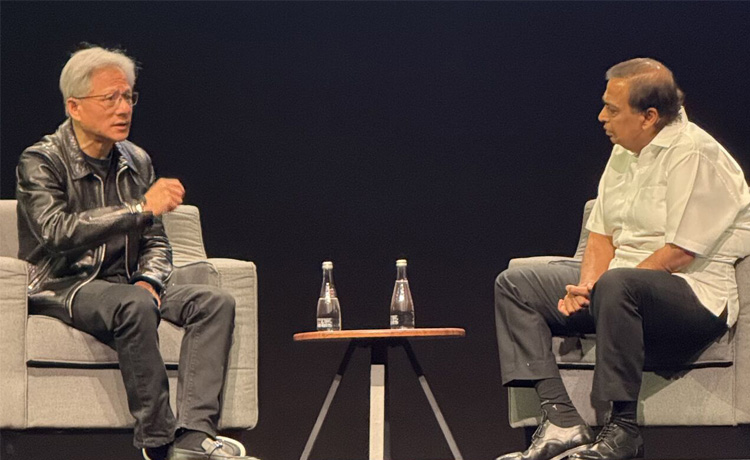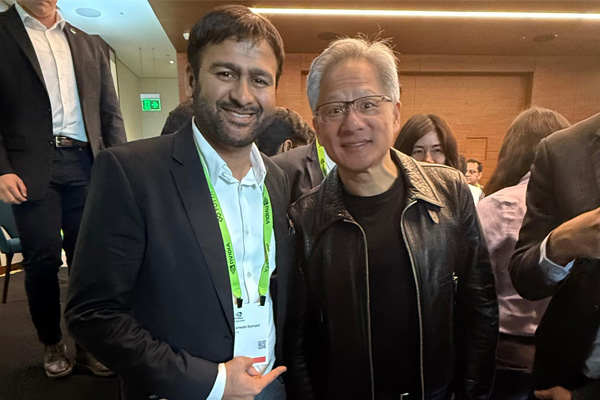
The first-ever Nvidia AI Summit kicked off with news that Reliance and Nvidia have joined hands to build and develop AI infrastructure in India. The announcement was made jointly by Reliance MD and Chairman Mukesh Ambani and Nvidia CEO Jensen Huang during a fireside chat where they discussed their AI strategy for India.
The keynote started on a rather funny note when Huang entered the stage without his slide changer and had to scurry back in to fetch it. Being his witty self, he handled the situation with grace. The keynote was also attended by Bollywood actor Akshay Kumar, who bluntly asked Huang, “What can AI do that humans cannot?” Huang’s response was one of assurance. He said, “AI has no possibility of doing all of what we do. But it can do 20% to 50% of our job 50 times better.”
Huang welcomed Mukesh Ambani onto the stage and acknowledged his contributions to making India hi-tech. When asked what motivated him in his drive, Ambani gave an anecdote about how he has always interpreted the word ‘Nvidia’ as ‘Vidya,’ the Hindi word for knowledge. He also spoke about his aspiration to make the best Hindi LLM and make the benefits of generative AI accessible to a wider audience.

Mr Ramesh Somani with Mr Jensen Huang during the ongoing Nvidia AI Summit.
As part of their new partnership, Nvidia and Reliance will work together to build AI infrastructure that’s more powerful than the fastest supercomputer in India today. This will be achieved through the GH200 Grace Hopper Superchip and via DGX Cloud, the company’s AI supercomputing service in the cloud. With this infrastructure, Reliance hopes to provide AI applications and services for its 450 million Jio customers and also bring energy-efficient AI infrastructure to scientists, developers and startups across India.
The AI infrastructure resulting from this partnership between Reliance and Nvidia will be hosted in data centres in Jamnagar. Both companies plan to expand their capacities to 2,000 MW eventually.
Huang and Ambani even discussed how this partnership can help transform India from a centre of just IT to that of AI. Referring to the country’s overall mood as aspirational, Ambani said it’s one of the very few in the world with an average age below 35. He also mentioned India’s strong connectivity infrastructure, adding that India has some of the best digital connectivity via 4G, 5G, and broadband networks.
Huang acknowledged Reliance’s status as the largest data company in the world but retorted that the country’s market size is quite a big advantage. During the talk, the Nvidia CEO even brought up PM Narendra Modi, recounting how he told him that India should not export data to import intelligence and that AI holds the key to elevating India’s population. Ambani, meanwhile, praised Meta head Mark Zuckerberg for his decision to keep AI models open-source.
Following the keynote, Huang sat down for a media interaction, during which our Editor-in-chief, Mr. Ramesh Somani, asked, ” Will Nvidia also be seen in the field of robotics in the coming future?”
Huang answered, “We’re the only robotics company in the world that works with every robotics company in the world. Our goal is not to create AI applications. Our goal is to create the technology for AI companies to create AI. My job is to help AI companies create AI, deploy AI. Our job is to help robotics companies create robotics and deploy robotics. Our job is to help them build AVs – autonomous vehicles – and deploy AVs. Nvidia is an infrastructure company. A technology company. We have technology in systems. We also have technology in AI algorithms. Those AI algorithms are part of a platform called Nvidia AI Enterprise that Mukesh spoke about and Nvidia Omniverse that Mukesh spoke about. These two libraries, if you will, think of it as the operating systems of AI. The operating system of physical AI and the operating system of Agentive AI. And so this software technology then is used by Reliance. Our job is to provide them with the technology. They buy from us the technology and then our computer scientists work together to help them create artificial intelligence applications that they can deploy.”
In response to a question from another attendee about how India can avoid being relegated to a back-office role during the new age of intelligence revolution, Huang said, “Why export the labour while the software is built elsewhere? Why not manufacture the intelligence here and then export it?”
The partnership between Nvidia and Reliance signifies that Mukesh Ambani has been passed the baton to build India’s AI infrastructure. What will happen in the coming decades will be the result of this momentous occasion. Perhaps India will become an AI powerhouse. Perhaps India will manufacture its own chips. Only time will tell.

